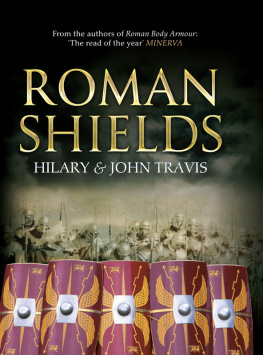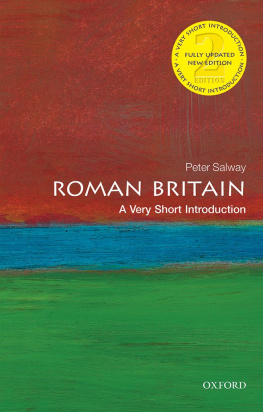
For Prof. D.L. Kennedy, who showed me the way

First published in Great Britain in 2014 by
Pen & Sword Military
an imprint of
Pen & Sword Books Ltd
47 Church Street
Barnsley
South Yorkshire
S70 2AS
Copyright M.C. Bishop 2014
ISBN 978 1 84884 615 9
eBook ISBN: 9781473837478
The right of M.C. Bishop to be identified as the Author of this Work has been asserted by him in accordance with the Copyright, Designs and Patents Act 1988.
A CIP catalogue record for this book is available from the British Library
All rights reserved. No part of this book may be reproduced or transmitted in any form or by any means, electronic or mechanical including photocopying, recording or by any information storage and retrieval system, without permission from the Publisher in writing.
Typeset in Ehrhardt by Mac Style, Bridlington, East Yorkshire Printed and bound in the UK by CPI Group (UK) Ltd, Croydon, CRO 4YY
Pen & Sword Books Ltd incorporates the imprints of Pen & Sword Archaeology, Atlas, Aviation, Battleground, Discovery, Family History, History, Maritime, Military, Naval, Politics, Railways, Select, Transport, True Crime, and Fiction, Frontline Books, Leo Cooper, Praetorian Press, Seaforth Publishing and Wharncliffe.
For a complete list of Pen & Sword titles please contact
PEN & SWORD BOOKS LIMITED
47 Church Street, Barnsley, South Yorkshire, S70 2AS, England
E-mail: enquiries@pen-and-sword.co.uk
Website: www.pen-and-sword.co.uk

Margarys (1973) network of Roman roads in Britain.
List of Figures
List of Plates
19. From main road to lane: the Roman road from Corinium to Cunetio near Ogbourne St George
Acknowledgements
Many people have aided me in one way or another during the writing of this book, a process that took nearly twenty years, off and on. Various individuals, groups, and societies listened politely to me talking on the subject of the roads of south-eastern Scotland and it was from that work that my wider interest in the Roman road system in Britain sprang. The Trimontium Trust and the Border Archaeological Society are just two of many who had to endure me harping on about roads, but I always found a sympathetic hearing in the company of Walter Elliot, Bill Lonie, and Donald Gordon, all motivational luminaries of the former society.
The late Raymond Selkirk showed me great kindness when I enquired about his speculative fort discovery at Press Mains in Berwickshire, whilst a casual comment of his about the neighbouring road led me on to pursue his line of thinking about a road continuing the Devils Causeway north of the Tweed.
A decade and a half of excavating for Northern Archaeological Associates Ltd and AOC Archaeology has provided many friends and colleagues who have tolerated my fixation about all things Roman, and even supplied the occasional road for me to dig (including several previously undiscovered ones).
Prof. David Kennedy first marched me across the Roman roads of Jordan, showed me recumbent milestones, cleared Severan tracks, and sportingly evinced a measure of tolerance and understanding at my poor efforts to keep up. He has gone on to be a source of wisdom, (sometimes impenetrably) dry wit, and useful contacts. What more can you ask of a person?
The wonderful Rupert Besley very gracefully allowed me to use his marvellous cartoon ( is Crown copyright: Royal Commission on the Ancient and Historical Monuments of Wales.
Particular, bejewelled thanks are due to Jon Coulston and John Poulter, both of whom read closely and commented insightfully upon an early draft of the text. I harbour no doubt that, without them, this would have been a much poorer book. However, whilst I have benefitted from and sought to incorporate their many suggestions, it is inevitable that I should stress that I alone am responsible for the doubtless many faults, idiocies, and inaccuracies remaining.
My long-suffering editor, Phil Sidnell, deserves a special award for his patience and his faith in me. I only hope he feels the wait, like the text, was justified. As a copy-editor myself, I think it is only fair also to thank my copy-editor, since I know how important (but seldom acknowledged) a job it can be. This book will inevitably be better for their gentle mistrinations (just testing).
Every book seeks to achieve a level of perfection, although few attain it. This one is doubtless just happy to be launched into the daylight, blinking and bedazzled, by its ungrateful and ridiculously tardy author, finally able to tell its tale.
Preface and Introduction
When light begins to glimmer, day to break, on the Dark Ages when daylight begins to flow, wavering, and spreads for us over the Dark Ages, what is the first thing we see? I will tell you what is the first thing I see. It is the Roads I see the Roads glimmer up out of that morning twilight, with the many men, like ants, coming and going upon them; meeting, passing, overtaking; knights, merchants, carriers; justiciars with their trains, kings messengers riding post; afoot, friars black, white and grey pardoners, poor scholars, minstrels, beggar-men; packhorses in files; pilgrims, bound for Walsingham, Canterbury, or to Southampton I see the old Roman roads hard metalled, built in fine layers I see the minor network of cross-roads. Arthur Quiller-Couch
This morning, I travelled along the Roman road from Corinium to Cunetio (Plate 19). The stretch south of Chiseldon is as straight as an arrow, unerringly dipping and soaring over a series of low hills. However, just 4.5 km from its target, which is now an open field next to the village of Mildenhall in Wiltshire, its course is suddenly abandoned and the modern road departs, wriggling across the landscape to arrive, finally, at the medieval market town of Marlborough, Cunetios successor. The Roman road blithely continues as a lane, a track, a path, and then a lane again. So, although a short length of it is no longer a major route, it continues to make its mark upon the landscape.
We all owe much to Roman roads, but I have long harboured the suspicion that most people do not realize quite how much. It has become customary to dismiss the Roman contribution to British history as minimal. Their sidelining in the National Curriculum is perhaps symptomatic: fun for kids, but not serious, formative history. I disagree.
This book has been written partly from the conviction that this assumption is quite simply wrong, but partly also to draw attention to what I have come to recognize as common threads that link us today with the Romans and beyond them to our prehistoric past. For, just as we underrate the Roman contribution to our heritage, we appear to be completely ignoring part of our prehistoric legacy: in both cases, it is the gift of an ever-evolving road network.
Roman roads affect the lives of everybody living in the British Isles in a way that more prominent monuments, such as (to take a deliberately provocative example) Stonehenge, never have done and never will. They are hardly romantic, nor are they likely to inspire much beyond the occasional ramblers guide book. However, a road system is quintessentially practical: it was the skeleton of the Roman province of Britannia, just as it was before the Romans even arrived, and just as it was to continue to be after their brief sojourn in terms of British history, at least was over. These roads have witnessed the wanderings of kings and scholars, the tramp of passing armies, and commerce between settlements that could not have existed without them. Our modern communication network, the siting of many of our cities and towns, even the very nature of who we are is linked to those roads. Unlike most monuments, many of them are still fulfilling their original role, one of which as we shall see was not new when the Romans arrived.
Next page




















